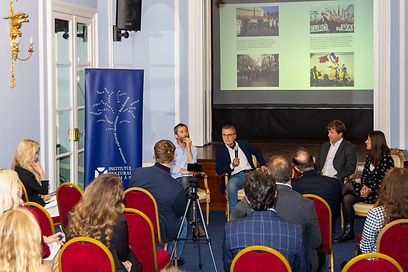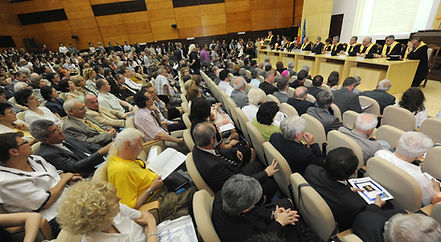
Victor Neumann:
Contributions to the European, Banat, Jewish and Conceptual History
By Carol Iancu
Paul Valéry University of Montpellier, France, Honorary Member, Romanian Academy
I am pleased to be associated with colleagues who had the wonderful idea of paying tribute to the distinguished historian Victor Neumann, whom I had the pleasure of meeting three decades ago, immediately after the political upheavals of 1989. Our initial meeting, due to our common professional occupations, has blossomed into a warm friendship. Among other things, two dedications testify to our lasting relationship that has grown over the years, and which summarize their evolution. The first was when Professor Neumann presented me with the first edition of his book, The Temptation of Homo Europaeus, with the inscription: “To Carol Iancu,
with the best thoughts and the hope of a long-lasting collaboration. V.N., Bucharest, January 7, 1993.” The second dedication is from the third edition of the same volume, and it reads: “To Carol Iancu, very fondly and with the hope that this book could also be a useful reference to the history of the Jews in the Balkans and Central Europe. V.N., Timişoara, January 27, 2014”.
Twenty-one years separates these two dedications, a time during which Professor Neumann made himself known among historians and for being an eminent researcher, one who made important contributions to the various strands of Clio’s universe. Four challenging realms have been thoroughly explored: European, Banat, Jewish and Conceptual History. The problems of the first three already are found in the volume I cited above and through which he has become well-known in academic, cultural and even political circles.
I propose here to sketch an outline of the main orientations that come from the four areas of the vast territory studied by my esteemed colleague. In The Temptation of Homo Europaeus, he deliberately chooses the geographic area of Central and South-Eastern Europe and aims to rediscover the past from “books that include a modern vision of these spaces”. This is all the more meritorious given that the vast majority of the writings devoted to the history of Europe exemplify only the Western space. Professor Neumann consecrated a whole chapter of the transition from medieval to modern times, invoking the echo of Renaissance in East-Central Europe and the Balkan Peninsula. Erasmus’s conceptions, dialogues and polemics with different personalities have attracted his attention, causing him to draw parallels between the West and East of the continent as far as the spirits of European thinking are concerned. He finds that therenewal of the humanist culture through art and science has taken place in schools set up by cities, and this culture was not just in the Occident. The historian cites the renewal, due to cultural interference, such as the Oradea Humanist Learning Center, where the diplomats of the
Hungarian Royal Court were formed. He also speaks of a Renaissance echo felt in the Balkans, insisting on the printing or transcription of Cyrillic books, as occurred in the printing houses of Belgrade and Skandar in the middle of the 16th century. Then he shows how in Wallachia and Moldavia, under the reigns of Matei Basarab and Vasile Lupu, the foundations of the humanist culture were established thanks to Orthodox Metropolitan Varlaam.
In presenting religious reform in East-Central Europe, the focus is on the consequences of Catholic propaganda. In the Age of Enlightenment, there was a real intellectual revolution that marked the European Man, but the events in Transylvania, Moldavia and Wallachia could not be broken by the thinking of the time: “The same decades that flow between 1791, the year of the
Supplex, and 1848, according to which the individual will have to guide himself to a right that belongs to him since his birth: the right to liberty”.
Resuming the thesis of Professor Răzvan Theodorescu relative to the cultural corridors of South-Eastern Europe during in the Middle Ages, Professor Neumann has expanded his research both in time and space, considering people who have propagated books, information, and ideas. He pursued “corridors facilitating communication from the north in Gothenburg to eastern Transylvania, from the Flemish world to the Austrian, Hungarian and Romanian universities, from the Halle and Berlin universities to Buda, Karlowitz, Sibiu, Blaj, Iasi, Bucharest not excluding Russia to Peter the Great or the Greek Mount Athos.” The multiple plans of the cultural dialogue have continued in other important books, including: Between Words and Reality. Studies on the Politics of Recognition and the Changes of Regime in Contemporary Romania (2001); Neam, Popor sau Națiune? (Kin, People or Nation?, 1st Edition, 2003, 2nd
edition, 2005, 3rd edition, 2015); and Essays on Romanian Intellectual History (1st Edition, 2008, 2nd Edition, 2013).
The second theme for which Professor Neumann has demonstrated a sincere passion is that of Banat. From Romanian historian’s point of view, Banat is “a region of convergence,” “a territory in which the civilizations of the Center and South-East intertwine, generating on the one hand the multiple internal dialogue, on the other hand, the great European dialogue.” Furthermore, a turntable of the area between Vienna and Constantinople”. Banat is also the birthplace of Professor Neumann; this story also is woven through studies and books. The various linguistic and religious communities that coexisted with the Romanians benefited from a rich description, thus understanding the dialogue with Central and Western Europe, the Balkans and before and after Byzantium. It is the note of originality in Banat, a region located between two worlds, between two civilizations and influenced by the ideas of the French Revolution, which gave rise
to a “form of manifestation of bourgeois democratism”.
Banat is present in many historical writings, coordinated collective volumes including the most important, Identitate și Cultură. Studii privind istoria Banatului (Identity and Culture. Studies on Banat History, 2009) and Istoria Banatului. Studii privind particularitățile unei regiuni transfrontaliere (History of The Banat. The Peculiarities of a Cross-Border Region, 1st edition, 2015, 2nd editions, 2016). Professor Neumann is the author of most chapters among the 23 contributions included in the final edition entitled, The Banat of Timişoara. A European Melting Pot (Scala Arts & Heritage, London, 2019). It is a highly relevant synthesis, one that explains in
detail the genesis of the region’s particularities due to the cultural diversity of its inhabitants.
The third theme is present in a remarkable chapter in Homo Europaeus entitled, “A convergence-generating diaspora? Radiation of Judaism in Central and South-Eastern Europe”. Professor Neumann has succeeded here in a fascinating fresco of the Jewish community, with particular attention being given to the original diaspora, namely to Sephardic people expelled from the Iberian Peninsula at the end of the 15th century, and who found special refuge in the Ottoman Empire. The attraction for the history of the Jews has as its starting point the observation that “the Jew is the most important alterity within the European civilization”. Analyzing a little-known Jewish diaspora, the historian shows that the presence of Jews in the Balkans and Pannonia dates back to Antiquity, noting that archaeological excavations in Greece, the former Yugoslavia, Hungary and Romania have led to the discovery of new testimonies, especially in archaeological research. For medieval and modern epochs, rabbinic responses evoke facts and events about everyday life. When describing the major centers of the Jewish diaspora in South-Eastern Europe, the historian does not miss out on any outstanding events: Neither the controversial problem of the Khazars nor the false Messianism represented by Sabbatai Zevi; nor the Kabbalist universe, nor the mystical movement of Hasidism; neither the encyclopedic culture of the Jews nor the changing intellectual orientations of the century of Enlightenment (the role of engine being played by Moses Mendelssohn, the Father of Haskalah) in a vast geographic territory including Boemia, Austria, Hungary, Transylvania, Banat, Maramureş, Moldova, Wallachia, Serbia, Bosnia and Greece.
The author has returned to the history of the Jews in a series of studies that have been gathered under the titles of the Istoria evreilor din România. Studii documentare și teoretice (History of the Jews in Romania. Documentary and Theoretical Studies, 1st edition, 1996, second edition, 2018); and History of the Jews in Banat. A testimony of the multi- and interculturality of East-Central Europe (1999). In the first collection, research is devoted to the Jewish emancipation, Jewish-Romanian cultural and political relations in the Old Kingdom of Romania, their condition in Romania during the interwar years and under the Antonescu regime, as well as the
“controversial case” during the communist totalitarian regime. The second collection includes descriptions of the Jewish communities in the 18th century, religious reform and political emancipation in the 19th century, their situation during the reign of King Carol II, Ion
Antonescu’s fascist dictatorship, and dictatorship of the communist regime. It is worth mentioning two other articles in the volume Identitate și Cultură. Studii privind istoria Banatului (Identity and Culture. Studies on the History of Banat): “Ecoul pogromului de la Iași în presa din Banat” (The Echo of the Iași Pogrom in Banat Press) and “Evreii din Banat și Transilvania de sud în timpul celui de-al doilea război mondial” (The Jews of Banat and Southern Transylvania in the Second World War). All of these are contributions based on numerous archived sources, on a broad bibliography, but also on keen analyses, contextualization and original
interpretations.


Presentation and debate at the Romanian Cultural Institute in London (May 2022) about the book Kin, People or Nation? On European Political Identities, Translated by Gabi Reigh and Neil Titman, Foreword by Hans Erich Boedeker, Scala Arts and Heritage Publishers, London, 2021. In the photo: Professor Dan Stone (Royal Holloway University of London), Neil Titman (Editor, Scala Publishers), Gabi Reigh (Translator) and Victor Neumann (book author).
Reading Laudatio for King Michael of Romania during the ceremony of awarding the Doctor Honoris Causa title at the West University of Timișoara, 2009.